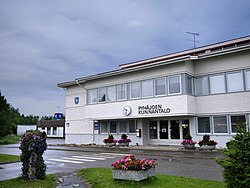Pyhäjoki
Pyhäjoki | |
|---|---|
Municipality | |
| Pyhäjoen kunta Pyhäjoki kommun | |
 Pyhäjoki Municipal Hall | |
 Location of Pyhäjoki in Finland | |
| Coordinates: 64°27′50″N 24°15′40″E / 64.46389°N 24.26111°ECoordinates: 64°27′50″N 24°15′40″E / 64.46389°N 24.26111°E | |
| Country | |
| Region | North Ostrobothnia |
| Sub-region | Raahe |
| Charter | 1865 |
| Government | |
| • Municipal manager | Matti Soronen |
| Area (2018-01-01)[1] | |
| • Total | 1,365.09 km2 (527.06 sq mi) |
| • Land | 542.06 km2 (209.29 sq mi) |
| • Water | 823.25 km2 (317.86 sq mi) |
| • Rank | 159th largest in Finland |
| Population (2021-12-31)[2] | |
| • Total | 3,045 |
| • Rank | 219th largest in Finland |
| • Density | 5.62/km2 (14.6/sq mi) |
| Population by native language | |
| • Finnish | 98.8% (official) |
| • Swedish | 0.4% |
| • Others | 0.9% |
| Population by age | |
| • 0 to 14 | 17.4% |
| • 15 to 64 | 53.4% |
| • 65 or older | 29.3% |
| Time zone | UTC+02:00 (EET) |
| • Summer (DST) | UTC+03:00 (EEST) |
| Municipal tax rate[5] | 20.75% |
| Website | www.pyhajoki.fi |
Pyhäjoki (Finnish pronunciation: [ˈpyhæˌjoki]; literally the "Holy River") is a municipality of Finland. It is located in the defunct province of Oulu, which was split in two regions; Pyhäjoki is part of the Northern Ostrobothnia region. It is located 102 kilometres (63 mi) southwest of the city of Oulu.
The municipality is located on the Gulf of Bothnia at the mouth of the river Pyhäjoki. It has a population of 3,045 (31 December 2021)[2] and covers an area of 1,365.09 square kilometres (527.06 sq mi) of which 823.25 km2 (317.86 sq mi) is water.[1] The population density is 5.62 inhabitants per square kilometre (14.6/sq mi). The municipality is unilingually Finnish.
The subject of the coat of arms of Pyhäjoki refers to the large boulder of Hanhikivi ("Goose Rock") near the mouth of the Pyhäjoki river, which was considered by the Russians at the end of the 15th century as the landmark of the Treaty of Nöteborg from 1323; a crown and cross pattern is carved into the stone as a landmark. The coat of arms was designed by Olof Eriksson and approved by the Pyhäjoki Municipal Council at its meeting on June 18, 1965. The Ministry of the Interior confirmed the use of the coat of arms on September 22 of the same year.[6][7]
Fennovoima, a Finnish nuclear power company, plans to build a nuclear power plant at Hanhikivi in the municipality. The power plant would be operational in 2029.[8]
References
- ^ a b "Area of Finnish Municipalities 1.1.2018" (PDF). National Land Survey of Finland. Retrieved 30 January 2018.
- ^ a b "Preliminary population structure by area, 2021M01*-2021M12*". StatFin (in Finnish). Statistics Finland. Retrieved 2 February 2022.
- ^ "Population according to language and the number of foreigners and land area km2 by area as of 31 December 2008". Statistics Finland's PX-Web databases. Statistics Finland. Retrieved 29 March 2009.
- ^ "Population according to age (1-year) and sex by area and the regional division of each statistical reference year, 2003–2020". StatFin. Statistics Finland. Retrieved 2 May 2021.
- ^ "List of municipal and parish tax rates in 2021" (PDF). Tax Administration of Finland. 1 December 2020. Retrieved 10 April 2021.
- ^ Suomen kunnallisvaakunat (in Finnish). Suomen Kunnallisliitto. 1982. p. 132. ISBN 951-773-085-3.
- ^ "Sisäasiainministeriön vahvistamat kaupunkien, kauppaloiden ja kuntien vaakunat 1949-1995 I:12 Pyhäjoki" (in Finnish). Kansallisarkiston digitaaliarkisto. Retrieved September 27, 2021.
- ^ "New nuclear reactor to be built at Pyhäjoki". YLE News. Helsinki: Yleisradio Oy. 5 October 2011. Archived from the original on 25 October 2011. Retrieved 5 October 2011.
External links
![]() Media related to Pyhäjoki at Wikimedia Commons
Media related to Pyhäjoki at Wikimedia Commons
- Municipality of Pyhäjoki – Official website
- Pages with non-numeric formatnum arguments
- CS1 Finnish-language sources (fi)
- Articles with short description
- Short description with empty Wikidata description
- Articles containing Finnish-language text
- Articles containing Swedish-language text
- Coordinates not on Wikidata
- Commons category link is defined as the pagename
- AC with 0 elements
- Pyhäjoki
- Populated coastal places in Finland
- Populated places established in 1865
- All stub articles
- Oulu Province geography stubs


